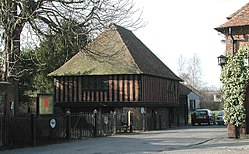Fordwich: Difference between revisions
| Line 21: | Line 21: | ||
The town grew in the Middle Ages as a port for boats on their way upriver to [[Canterbury]]. All of the Caen stone used by the Normans to rebuild Canterbury Cathedral in the 12th and 13th centuries was landed at Fordwich. It later became a limb of the [[Cinque Ports]]. It lost its status as a town in 1880 when it no longer had a Mayor and Corporation. However, in a reorganisation in 1972, Fordwich was again made a Town as much as anything because of its prior importance in what is now a rather sleepy corner of Kent. Fordwich Town Hall, supposedly the smallest in England, dates from the earlier period, having been rebuilt in 1555. | The town grew in the Middle Ages as a port for boats on their way upriver to [[Canterbury]]. All of the Caen stone used by the Normans to rebuild Canterbury Cathedral in the 12th and 13th centuries was landed at Fordwich. It later became a limb of the [[Cinque Ports]]. It lost its status as a town in 1880 when it no longer had a Mayor and Corporation. However, in a reorganisation in 1972, Fordwich was again made a Town as much as anything because of its prior importance in what is now a rather sleepy corner of Kent. Fordwich Town Hall, supposedly the smallest in England, dates from the earlier period, having been rebuilt in 1555. | ||
The ancient Church of St Mary the Virgin, now | The ancient Church of St Mary the Virgin, now redundant but open to the public, and in the care of the Churches Conservation Trust, contains part of a carved sarcophagus reputed to have contained the remains of St Augustine of Canterbury. The 16th-century building next the Town Hall, now known as Watergate House, was the family home of John and Gregory Blaxland, early 19th-century pioneers of Australia. | ||
==Culture and community== | ==Culture and community== | ||
Latest revision as of 22:06, 4 June 2013
| Fordwich | |
| Kent | |
|---|---|
 Fordwich Town Hall | |
| Location | |
| Grid reference: | TR179597 |
| Location: | 51°17’43"N, 1°7’28"E |
| Data | |
| Post town: | Canterbury |
| Postcode: | CT2 |
| Dialling code: | 01227 |
| Local Government | |
| Council: | Canterbury |
| Parliamentary constituency: |
Canterbury |
Fordwich (ˈfɔrdwɪtʃ) is the smallest place in Britain with a town council,[1] having a population of 351 recorded in the 2001 census. It lies in Kent, on the River Stour, northeast of Canterbury.
Although it now lies many miles inland, it was the main port for Canterbury before the Wantsum Channel silted up. The channel once separated the Isle of Thanet from the rest of Kent.
History
The town grew in the Middle Ages as a port for boats on their way upriver to Canterbury. All of the Caen stone used by the Normans to rebuild Canterbury Cathedral in the 12th and 13th centuries was landed at Fordwich. It later became a limb of the Cinque Ports. It lost its status as a town in 1880 when it no longer had a Mayor and Corporation. However, in a reorganisation in 1972, Fordwich was again made a Town as much as anything because of its prior importance in what is now a rather sleepy corner of Kent. Fordwich Town Hall, supposedly the smallest in England, dates from the earlier period, having been rebuilt in 1555.
The ancient Church of St Mary the Virgin, now redundant but open to the public, and in the care of the Churches Conservation Trust, contains part of a carved sarcophagus reputed to have contained the remains of St Augustine of Canterbury. The 16th-century building next the Town Hall, now known as Watergate House, was the family home of John and Gregory Blaxland, early 19th-century pioneers of Australia.
Culture and community
There are two pubs in the town, the George & Dragon and Fordwich Arms. Fordwich is also known as the home of a legendary large fish (according to Izaak Walton): the Fordwich trout.
See also
- Manningtree in Essex, the other claimant for smallest town in England, with 700 people in 49 acres
- Llanwrtyd Wells has a population of 601
Outside links
| ("Wikimedia Commons" has material about Fordwich) |
References
- ↑ Matthews, Peter (1992), The Guinness Book of Records, 1993, Guinness World Records Limited, ISBN 978-0-85112-978-5
